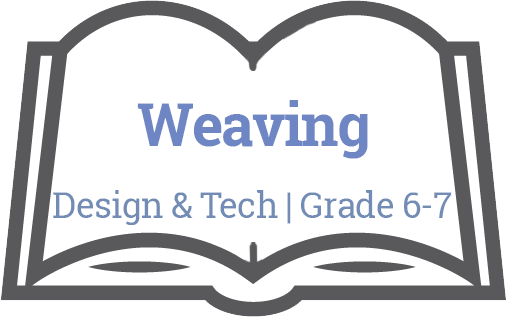
Unit Plan: Weaving
Applied Design, Skills & Technology / Grade 6-7

Big Ideas
Design can be responsive to identified needs.
Concepts:
- Function
- Form
- Causation
- Connection
Essential Questions
Students will keep considering…
- How are textiles used in functional ways?
- What are the features of woven textiles?
- How do we describe patterns?
Evaluative Criteria
Rubric
- Student will be able to expertly describe a wide variety of functions of woven textiles both in the past and in the present.
- Students will be able to describe in detail the features of their finger-woven textile piece using advanced vocabulary.
- Student can expertly create a finger woven piece that includes even tension throughout and a clear pattern in the weaving.
- Student is able to clearly describe the pattern using mathematical language.
Monitoring Progress
Teacher will monitor progress:
Teachers can monitor progress through ongoing formative assessment including but not limited to:
- Students could write, draw or share reflections on their learning throughout this process that teachers could assess.
- Teachers could assess their woven product.
- Teachers could assess their mathematical descriptions of their patterns.
Resources
WEBSITES
TEXT
- “The Arrow Sash” / “La cienture fleche” by Sylvain Rivard
- “Fingerweaving Untangled” / “Le fléché démêlé” by Carol James
Reflection
How will teachers and their students reflect on and evaluate the completed project?
Teacher Reflection
- What aspects of the unit went well?
- What did students struggle with?
- What did you struggle with?
- What would you add/revise the next time you taught this unit?
- Were there any unintended outcomes?
- Were students engaged?
Downloads
Stage 3 – Learning Plan
EXECUTE THE LEARNING PLAN
LEARNING EVENTS:
- These learning events/activities are suggested activities only.
- In some cases the plans are not fully completed lesson plans.
- The teacher may choose some lessons/activities to span over several lessons.
- Teachers may add, revise and adapt these lessons based on the needs of their students, their personal preferences for resources, and the use of a variety of instructional techniques.
Learning events are enriched for students when teachers consider the “WHERE TO” acronym and guiding organizer by Wiggins and McTighe.
The Learning Events should always be prefaced by focusing on the essential questions:
- How are textiles used in functional ways?
- What are the features of woven textiles?
- How do we describe patterns?
Acquisition-Meaning-Transfer
Lesson 1 - How Are Textiles Used in Functional Ways?
The Learning Events should always be prefaced by focusing on the essential questions:
- How are textiles used in functional ways?
- What are the features of woven textiles?
- How do we describe patterns?
How Are Textiles Used in Functional Ways? (Lesson 1)
1) Read aloud “The Arrow Sash” “La cienture fleche” by Sylvain Rivard.
2) Discuss how the arrow sash was used historically and how textiles are used now.
3) Have students reflect on their discussion in a way that the teacher can assess their learning.
Lesson 2 - What Are the Features of Woven Textiles?
The Learning Events should always be prefaced by focusing on the essential questions:
- How are textiles used in functional ways?
- What are the features of woven textiles?
- How do we describe patterns?
What Are the Features of Woven Textiles? (Lesson 2)
1) Using the book “Fingerweaving Untangled” by Carol James and the Sashweaver website, teach students the basic steps and vocabulary of finger-weaving.
2) Introduce how to create patterns in a weave.
3) Have students create their own mini Métis-inspired sash
4) Have students reflect on their learning in a way that the teacher can assess their understanding of finger-weaving vocabulary and process.
Lesson 3 - How Do We Figure Out and Describe Patterns?
The Learning Events should always be prefaced by focusing on the essential questions:
- How are textiles used in functional ways?
- What are the features of woven textiles?
- How do we describe patterns?
How Do We Figure Out and Describe Patterns? (Lesson 3)
1) Teach students to represent weaving patterns using concrete, pictorial, and symbolic mathematical forms.
2) Have students independently describe their final project using pictorial and symbolic mathematical forms.

The following resources are made available through the British Columbia Ministry of Education. For more information, please visit BC’s New Curriculum.
Big Ideas
The Big Ideas consist of generalizations and principles and the key concepts important in an area of learning. The Big Ideas represent what students will understand at the completion of the curriculum for their grade. They are intended to endure beyond a single grade and contribute to future understanding.
Core Competencies
 Communications Competency
Communications Competency
The set of abilities that students use to impart and exchange information, experiences and ideas, to explore the world around them, and to understand and effectively engage in the use of digital media
 Thinking Competency
Thinking Competency
The knowledge, skills and processes we associate with intellectual development
 Social Competency
Social Competency
The set of abilities that relate to students’ identity in the world, both as individuals and as members of their community and society
Curricular Competencies & Content
Curricular Competencies are the skills, strategies, and processes that students develop over time. They reflect the “Do” in the Know-Do-Understand model of curriculum. The Curricular Competencies are built on the thinking, communicating, and personal and social competencies relevant to disciplines that make up an area of learning.
Additional Resources
First People's Principles of Learning
To read more about First People’s Principles of Learning, please click here.
For classroom resources, please visit the First Nations Education Steering Committee.
